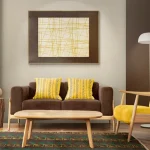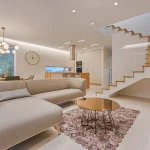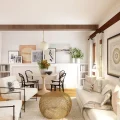Let’s be honest – everyone wants a home that feels a little more stylish, a little more pulled together, and maybe even a little more expensive. The good news? You don’t need to knock down walls or spend a fortune to make it happen. A few thoughtful changes in your home’s design can go a long way. From lighting and colours to fabrics and small details, the right updates can completely change how a space looks and feels.
Here are some simple interior design tricks that can help your home feel more expensive, without the luxury price tag.
1. Prioritise the Bedroom
The bedroom often gets overlooked when it comes to home upgrades, but it’s one of the most important spaces to get right. It’s where you rest, reset, and spend a large portion of your time. A few small changes can make it feel calm, stylish, and more expensive without needing to spend a lot.
Start with the bed. If yours isn’t as comfortable as it should be, it might be time for an upgrade. Panda offers mattresses that combine comfort and thoughtful design, helping your bedroom feel more relaxed and well put together.
Once your bed is sorted, keep the rest of the room simple. Choose soft, neutral bedding, add a textured throw, and bring in some warm lighting. These little touches can make the space feel polished and inviting, even on a small budget.
2. Stick to a Neutral Colour Palette
Neutral colours always look timeless and polished. Whites, greys, taupes, and soft earth tones help create a calm, clean atmosphere. They also make a room feel bigger and brighter, which naturally gives it a more expensive look.
Try using a few shades in the same colour family to keep your space from looking flat. You can add interest through layers—think cream walls, light grey curtains, and a sand-coloured rug. It’s easy on the eyes and makes your home feel thoughtfully styled without being overwhelming.
3. Add Texture Through Fabrics and Materials
Texture plays a huge role in making your home feel warm and inviting. It also gives the impression that a space has been designed with care. You can add texture in so many ways—throw blankets, cushions, rugs, or even lampshades.
Mixing materials is key. Combine soft fabrics like linen and velvet with harder textures like wood and brushed metal. A chunky knit throw over the back of a chair or a velvet cushion on your sofa instantly makes things feel richer. Even switching to textured curtains or adding a woven basket can make a space feel more high-end.
4. Use Lighting to Create Atmosphere
Lighting is one of the easiest ways to change the mood of a room, yet it’s often overlooked. Relying only on overhead lights can make your space feel flat and cold. Instead, try layering your lighting.
Use a mix of table lamps, floor lamps, and wall lights to give the room depth. Choose warm-toned bulbs to create a cosy, inviting feel. Dimmers are another great tool—they let you control the brightness based on the time of day or activity. Whether you’re relaxing in the evening or working from home, the right lighting can help set the tone.
Pendant lights above a dining table or stylish bedside lamps can double as statement pieces while still being functional.
5. Upgrade Small Details Like Handles and Fixtures
Sometimes it’s the small things that make the biggest difference. Swapping out old cupboard handles, drawer pulls, or light switch covers can instantly give a room a more finished look.
Choose finishes that match the overall style of your home—brushed brass, matte black, or even antique bronze can look sleek and elegant. These small upgrades are inexpensive but help your space look more custom and less builder-basic.
If you’re updating your bathroom or kitchen, changing taps or cabinet knobs can breathe new life into the room without a full renovation.
6. Keep Surfaces Clutter-Free
Nothing makes a home look more expensive than a tidy, well-organised space. When surfaces are clear and everything has a place, the whole room feels calmer and more intentional.
Use trays to group smaller items like candles or books on a coffee table. Add a few decorative boxes or baskets to hide everyday essentials. Built-in or hidden storage is ideal, but even simple changes like using matching storage containers can clean up your visual space.
Avoid overcrowding shelves or countertops. A few well-chosen items have more impact than a cluttered collection.
7. Bring Balance with Symmetry
Symmetry is a simple design principle that often gets overlooked, but it can completely change the way a room feels. It creates a sense of balance and calm, which naturally makes a space look more expensive. The best part? You don’t need to spend anything to get it right.
In the bedroom, try using matching bedside tables and lamps on either side of the bed. This doesn’t mean everything needs to be identical—just visually balanced. In a living room, arrange furniture around a central point, like a coffee table or fireplace. Use cushions, side tables, or artwork in pairs to create a more structured layout.
Symmetry also works well in dining areas. Placing chairs evenly around the table and hanging a light fixture in the centre helps the room feel finished. These are small changes, but they bring a sense of order and thoughtfulness that stands out.
There’s no need to spend thousands to make your home feel stylish and high-end. With a few simple updates—like layering textures, improving lighting, or upgrading your mattress—you can create a space that feels more comfortable and looks more expensive.
Start with one room and take your time. It’s not about perfection. It’s about creating a home that feels good to live in and reflects your personal style. Whether you’re refreshing your bedroom or updating a few fixtures, the small details matter. And often, they’re all you need to make a big difference.










